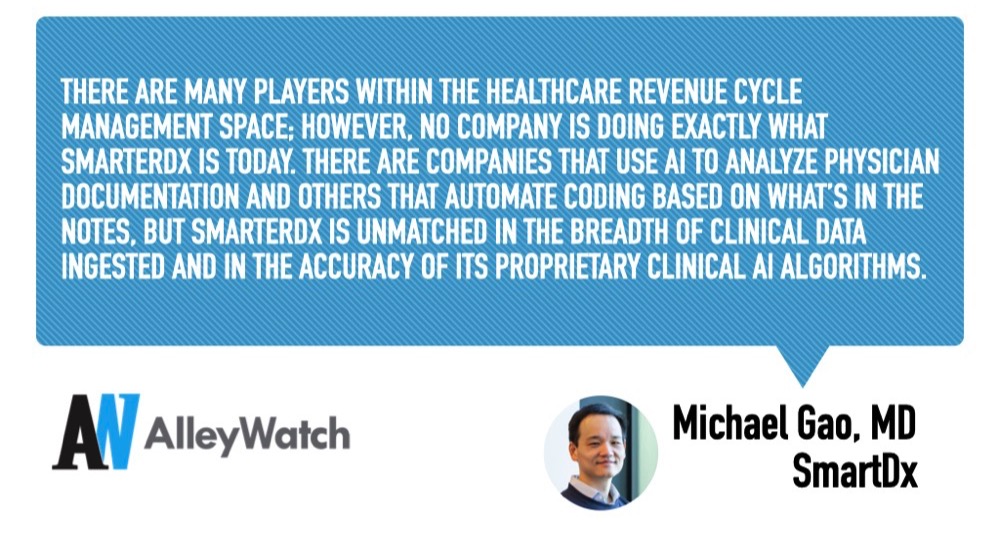Insurance claim denials represent a significant financial challenge for healthcare providers, with 10% of hospital-filed claims facing initial rejection. This results in substantial cash flow difficulties. However, modest investments in refining billing processes can substantially improve both patient care and financial outcomes. SmarterDx, a clinical AI platform, leverages over 30,000 data points per patient encounter to automate the generation of billing codes. It also ensures their reconciliation with other aspects of care delivery, guaranteeing precise billing for services rendered. The platform’s automation aids in enhancing documentation, thereby reducing the likelihood of claim denials. It streamlines the staffing requirements for billing operations and empowers healthcare professionals to concentrate on patient care rather than administrative duties. With SmarterDx, healthcare systems have discovered an average increase of $2M in annual revenue for every 10,000 patients managed, yielding a 5:1 return on investment 5:1, making the company’s solution an immediate value add.
AlleyWatch caught up with SmarterDx Cofounder and CEO Dr. Michael Gao to learn more about the business, the company’s strategic plans, latest round of funding, which brings the company’s total funding raised to $71M, and much, much more…
Who were your investors and how much did you raise?
We raised $50M in Series B funding led by Transformation Capital, including continued investments from Bessemer Venture Partners, Flare Capital Partners,and Floodgate Fund.
Tell us about the product or service that SmarterDx offers.
The average U.S. hospital operates on a 1.6% margin – meaning they live paycheck to paycheck – and struggle to get paid fairly for the care they provide. The reason is that generating accurate and complete receipts requires both an understanding of the nuances of clinical care and a grasp of complex, esoteric medical billing rules. And, on top of that, well-resourced insurance companies use layers of sophisticated AI tools and teams of expert physicians to validate these receipts.
SmarterDx helps even the playing field by bringing hospitals AI that reconciles the clinical and billing worlds. Our proprietary clinical AI, developed in-house by physicians and data scientists, ingests 30,000 clinical data points per patient visit, connects each billing code with the underlying care (e.g. lab results, medications administered), and then identifies any remaining gaps. Hospitals use this technology to fortify each visit’s evidence layer and rectify missing physician documentation. In turn, they can capture millions in missed revenue for care they provided.
What inspired the start of SmarterDx? Prior to SmarterDx, I was a hospitalist who also led applied AI at NewYork-Presbyterian. I observed that despite significant investment in documentation improvement and coding, the manual reviews done by the physicians on the quality review team always found more opportunities — but they could only review a small slice of charts and were expensive to employ for this administrative task. My fellow cofounders, Joshua Geleris, MD, and Nathan Perilo, and I started building clinical AI to help hospitals review 100 percent of charts and achieve 100 percent revenue integrity, enabling them to safeguard millions in revenue leakage and ensure that care quality is accurately represented.
Prior to SmarterDx, I was a hospitalist who also led applied AI at NewYork-Presbyterian. I observed that despite significant investment in documentation improvement and coding, the manual reviews done by the physicians on the quality review team always found more opportunities — but they could only review a small slice of charts and were expensive to employ for this administrative task. My fellow cofounders, Joshua Geleris, MD, and Nathan Perilo, and I started building clinical AI to help hospitals review 100 percent of charts and achieve 100 percent revenue integrity, enabling them to safeguard millions in revenue leakage and ensure that care quality is accurately represented.
How is SmarterDx different?
Our approach is rooted in the idea that AI solutions should complement the expertise of the professionals trained to do this work – not replace them. By eliminating the manual administrative tasks humans aren’t particularly adept at performing, we empower CDI teams to work at the top of their profession. For example, scouring 30,000 data points for one patient visit to confirm the diagnoses are complete and accurate is incredibly tedious. With our AI, in just seconds CDI teams are presented with recommendations, including supporting evidence from the record, that they can validate with their clinical judgment.
What market does SmarterDx target and how big is it?
Our target customer is large acute care hospitals, and our estimate for the current product is about $1.5 – 2.0B TAM.
What’s your business model?
We employ a contingency-based model: SmarterDx is paid a percentage of the cost savings achieved or new revenue generated. Hospitals only pay a set rate for the findings that their CDI team approves and begin realizing net new revenue on Day One. Additionally, if hospitals improve upstream processes, they pay less. This model has contributed to the company’s rapid growth because it minimizes financial risk for the hospital.
How are you preparing for a potential economic slowdown?
As a company, we have an incredibly strong balance sheet and have been capital-efficient to date.
What was the funding process like?
At SmarterDx, we have always taken the approach that if we build the right solution to a solvable problem, investment will follow. For our seed round, we only spoke with a handful of quality investors and both our Series A and B were preempted by strategic investors who we were really excited to partner with.
What are the biggest challenges that you faced while raising capital?
If you put customers first, investment will follow. The reverse is not true! A lot of founders confuse investor interest and product-market fit; we did not.
What factors about your business led your investors to write the check?
There are many players within the healthcare revenue cycle management space; however, no company is doing exactly what SmarterDx is today. There are companies that use AI to analyze physician documentation and others that automate coding based on what’s in the notes, but SmarterDx is unmatched in the breadth of clinical data ingested and in the accuracy of its proprietary clinical AI algorithms. As a result, it’s deployed in the pre-bill stage – after final coding but before billing – meaning that it is additive to CDI teams’ existing technology. The advanced AI still finds millions in net new revenue and quality opportunities on top of what is captured upstream.

What are the milestones you plan to achieve in the next six months?
We plan to execute new clinical and financial data integrations and continue to refine our proprietary algorithms that identify untapped revenue and quality opportunities for customers. This investment will also support scale as the company expands, including improving real-time and periodic analytics reporting and enhancing white-glove client implementation and support.
What advice can you offer companies in New York that do not have a fresh injection of capital in the bank?
When we started, we bootstrapped (Josh and I did hospitalist shifts on the side; Nathan volunteered his time) for some time as we were building the underlying technology. Staying as lean as possible before product-market-fit is critical.
Where do you see the company going now over the near term?
SmarterDx counts 15 health systems across the U.S. as customers today, which means there are hundreds of hospitals that don’t have SmarterDx and therefore are leaving quality opportunities and millions of dollars of missed revenue on the table. It’s our aim to help as many hospitals and health systems as possible have the technology to be paid fairly for the care they’ve provided.
What’s your favorite restaurant in the city?
Bōm has an incredible Korean tasting menu.
You are seconds away from signing up for the hottest list in NYC Tech!
Sign up today
- SEO Powered Content & PR Distribution. Get Amplified Today.
- PlatoData.Network Vertical Generative Ai. Empower Yourself. Access Here.
- PlatoAiStream. Web3 Intelligence. Knowledge Amplified. Access Here.
- PlatoESG. Carbon, CleanTech, Energy, Environment, Solar, Waste Management. Access Here.
- PlatoHealth. Biotech and Clinical Trials Intelligence. Access Here.
- Source: https://www.alleywatch.com/2024/05/clinical-ai-medical-billing-code-revenue-management-platform-michael-gao/




